check engine AUDI A6 2015 Owner's Manual
[x] Cancel search | Manufacturer: AUDI, Model Year: 2015, Model line: A6, Model: AUDI A6 2015Pages: 314, PDF Size: 77.57 MB
Page 218 of 314
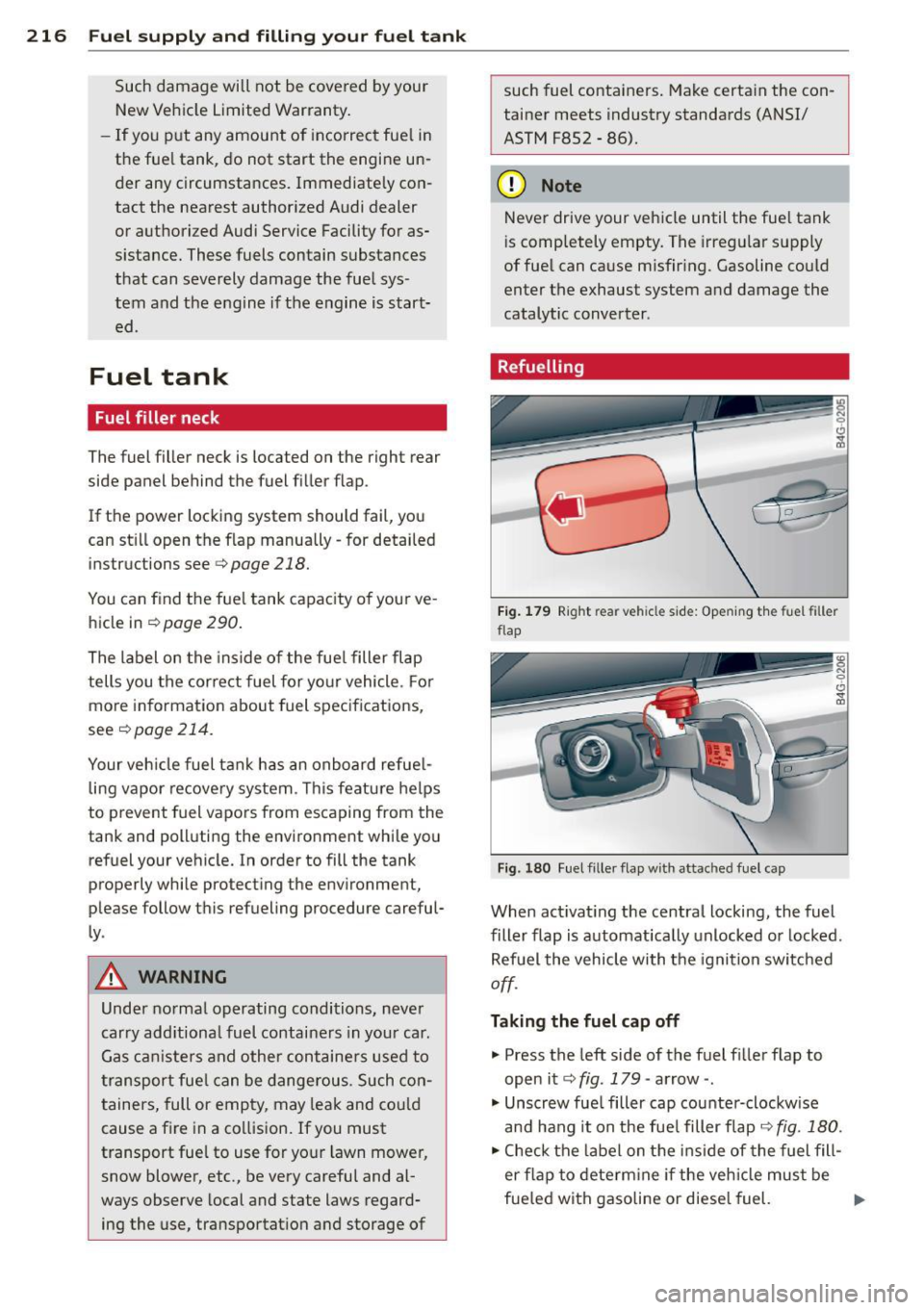
216 Fuel supply and filling your fuel tank
Such damage will not be covered by your
New Vehicle Limited Warranty.
- If you p ut any amount of incorrect fuel in
the fue l tank, do not start the engi ne un
der any circumstances. Immediately con
tact the nearest authorized Audi dealer
or authorized Audi Service Facility for as
s istance. These fuels contain substances
that can severely damage the fuel sys
tem and the engine if the engine is start ed.
Fuel tank
Fuel filler neck
The fuel filler neck is located on the right rear
side panel behind the fuel filler flap.
If the power locking system should fa il, you
can st ill open the flap manually -for detailed
instructions see
c;, page 218.
You can find the fue l tank capacity of your ve
hicle in
c;, page 290.
The label on the inside of the fue l filler flap
tells you the cor rect fuel for your vehicle . Fo r
more information about fuel specifications,
see
c;, page 214.
Your veh icle fuel tank has an onboard refue l
ling vapor recovery system. This feature helps
to prevent fuel vapors from escaping from the
tank and polluting the environment while you refuel your vehicle. In order to fill the tank
properly whi le protecting the env ironment,
please follow this refueling procedure careful
ly .
A WARNING
Under normal operating conditions, neve r
carry additiona l fuel containers in you r car.
Gas canisters and other containers used to
transport fuel can be dangerous. Such con
tainers, full or empty, may leak and could
cause a fire in a collision. If you must
transport fue l to use for yo ur lawn mower,
snow blower, etc., be very careful and al
ways observe local and state laws regard
ing the use, transportation and storage of such
fuel containers . Make certain the con
tainer meets industry standards (ANSI/
ASTM F852 -86).
(D Note
Never drive your vehicle until the fue l tank
is completely empty. The irregu lar supply
of fue l can cause misfiring. Gasoline could
enter the exhaust system and damage the
catalytic converter .
Refuelling
Fig. 179 Right rea r veh icle side: Opening the fuel filler
flap
Fig . 180 Fu el filler flap with attac hed fuel cap
When act ivat ing the central locking, the fuel
filler flap is automatically unlocked or locked.
Refuel the vehicle with the ignition switched
off.
Taking the fuel cap off
" Press the left side of the fuel filler flap to
open it
c;, fig. 179 -arrow -.
" Unscrew fuel filler cap counter-clockwise
and hang it on the fue l filler flap
c;, fig. 180.
"Check the label on the inside of the fuel fill
er f lap to determine if the veh icle must be
fue led with gasoline or diesel fuel.
Ill>
Page 224 of 314
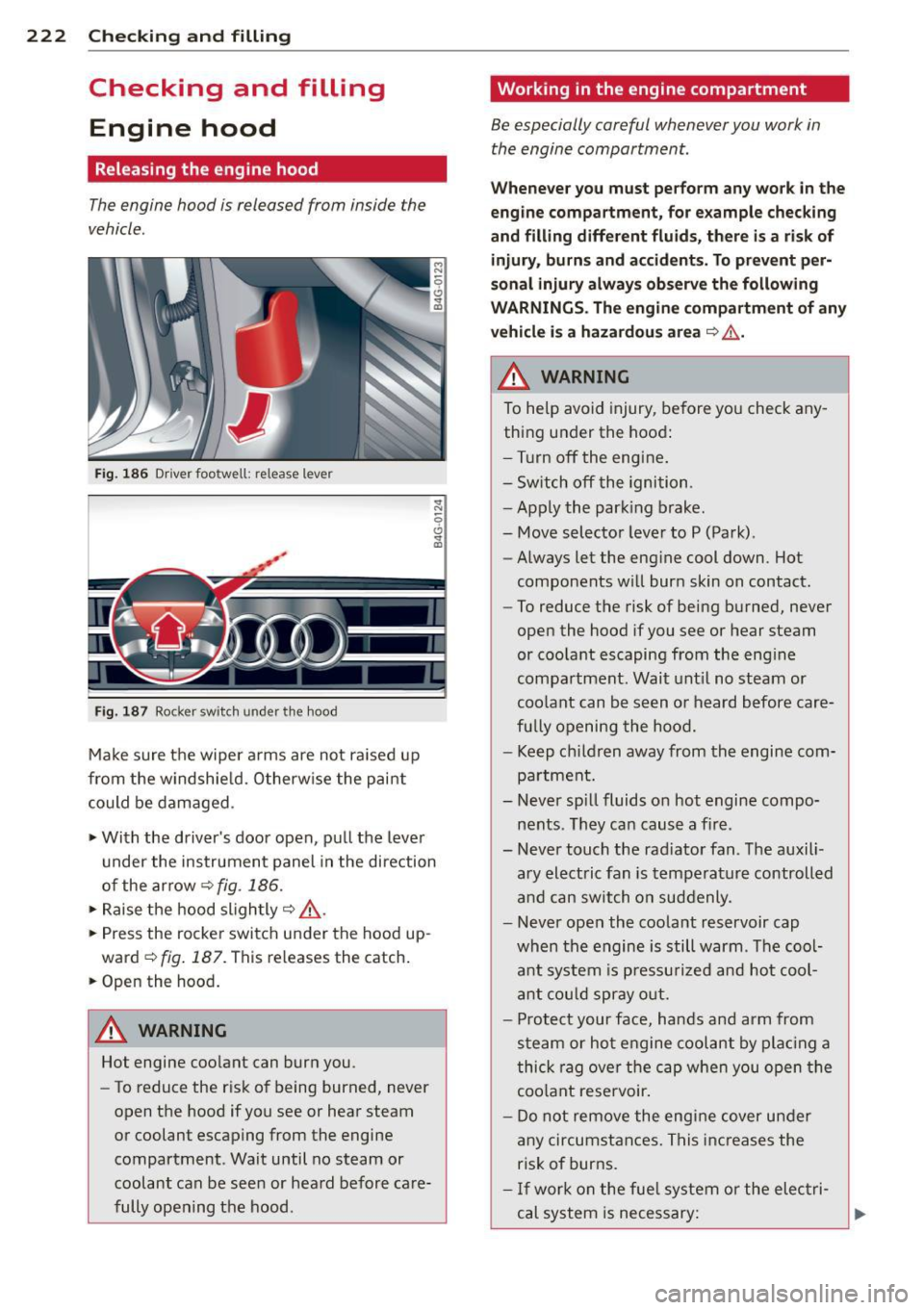
222 Checking and filling
Checking and filling Engine hood
Releasing the engine hood
The engine hood is released from inside the
vehicle .
Fig. 186 Driver foo twell: release lever
Fig. 187 Rocker switch un der the hood
Make sure the wiper arms are not raised up
from the windshield. Otherwise the paint
could be damaged .
.,. With the driver's door open, pull the lever
under the instrument panel in the direction
of the arrow ¢
fig. 186.
... Raise the hood slightly¢.&_ .
... Pr ess the rocker switch under the hood up
ward ~
fig. 187. This releases the catch.
.,. Open the hood.
A WARNING
Hot engine coolant can burn you.
- To reduce the risk of being burned, never
open the hood if you see or hear steam
or coolant escaping from the engine
compartment . Wait until no steam or
coolant can be seen or heard before care
fully opening the hood .
' Working in the engine compartment
Be especially careful whenever you work in
the engine compartment.
Whenever you must perform any work in the
engine compartment, for example checking
and filling different fluids, there is a risk of injury, burns and accidents. To prevent per
sonal injury always observe the following
WARNINGS. The engine compartment of any
vehicle is a hazardous area
¢ ,&. .
A WARNING
To help avoid injury, before you check any
thing under the hood:
- Turn off the engine.
- Switch off the ignition .
- Apply the parking brake.
- Move selector lever to P (Park).
- Always let the engine cool down. Hot
components will burn skin on contact.
- To reduce the risk of being burned, never
open the hood if you see or hear steam
or coolant escaping from the engine
compartment. Wait until no steam or
coolant can be seen or heard before care
fully opening the hood.
- Keep children away from the engine com
partment.
- Never spill fluids on hot engine compo
nents . They can cause a fire .
- Never touch the radiator fan. The auxili
ary electric fan is temperature controlled
and can switch on suddenly .
- Never open the coolant reservoir cap
when the engine is still warm . The cool
ant system is pressurized and hot cool
ant could spray out.
- Protect your face, hands and arm from
steam or hot engine coolant by placing a
thick rag over the cap when you open the
coolant reservoir.
- Do not remove the engine cover under
any circumstances. This increases the
risk of burns.
- If work on the fuel system or the electri-
cal system is necessary: ..,_
Page 225 of 314

M N
0 <.J 'SI: ,...., \!) 1.1'1 ,...., 1.1'1 ,....,
-Always disconnect the battery.
- Never smoke or work near heaters or open flames. Fluids in the engine com
partment could start a fire.
- Keep an approved fire extinguisher im
mediately available.
- To avoid electrical shock and personal in
jury while the engine is running or being
started, never touch :
- Ignition cables
- Other components of the high voltage
electronic ignition system.
- If you must perform a check or repair
with the engine running:
- First, fully apply the parking brake,
move selector lever to P (Park).
- Always use extreme caution to prevent
clothing, jewelry, or long hair from get
ting caught in the radiator fan, V-belts
or other moving parts, or from contact ing hot parts. Tie back hair before
starting, and do not wear clothing that
will hang or droop into the engine.
- Minimize exposure to emission and
chemical ha zards c:::> & .
A WARNING
California Proposition 65 Warning:
- Engine exhaust, some of its constituents,
and certain vehicle components contain
or emit chemicals known to the State of
California to cause cancer and birth de
fects and reproductive harm. In addition ,
certain fluids contained in vehicles and
certain products of component wear con
tain or emit chemicals known to the
State of California to cause cancer and
birth defects or other reproductive harm .
Checking and filling 223
-Battery posts, terminals and related ac
cessories contain lead and lead com
pounds, chemicals known to the State of
California to cause cancer and reproduc
tive harms. Wash hands after handling.
(D Note
When adding fluids, always make sure that
they are poured into the proper container
or filler opening, otherwise serious dam
age to vehicle systems will occur.
(® For the sake of the environment
To detect leaks in time, inspect the vehicle
floor pan from underneath regularly . If
you see spots from oil or other vehicle flu ids, have your vehicle inspected by an au
thorized Audi dealer.
Closing the engine hood
.,. Pull the hood down until the pressure from
the struts is reduced.
.,. Let the hood
drop down and latch in place.
Do not try to push it shut; it may fail to en
gage
c:::> ,A .
A WARNING
-
A hood that is not completely latched
could fly up and block your view while driv
ing .
- When you close the engine hood, check it
to make sure the safety catch has proper ly engaged. The hood should be flush
with the surrounding vehicle body parts.
- If you notice while driving that the hood
is not secured properly , stop at once and
close it. •
•
Page 226 of 314
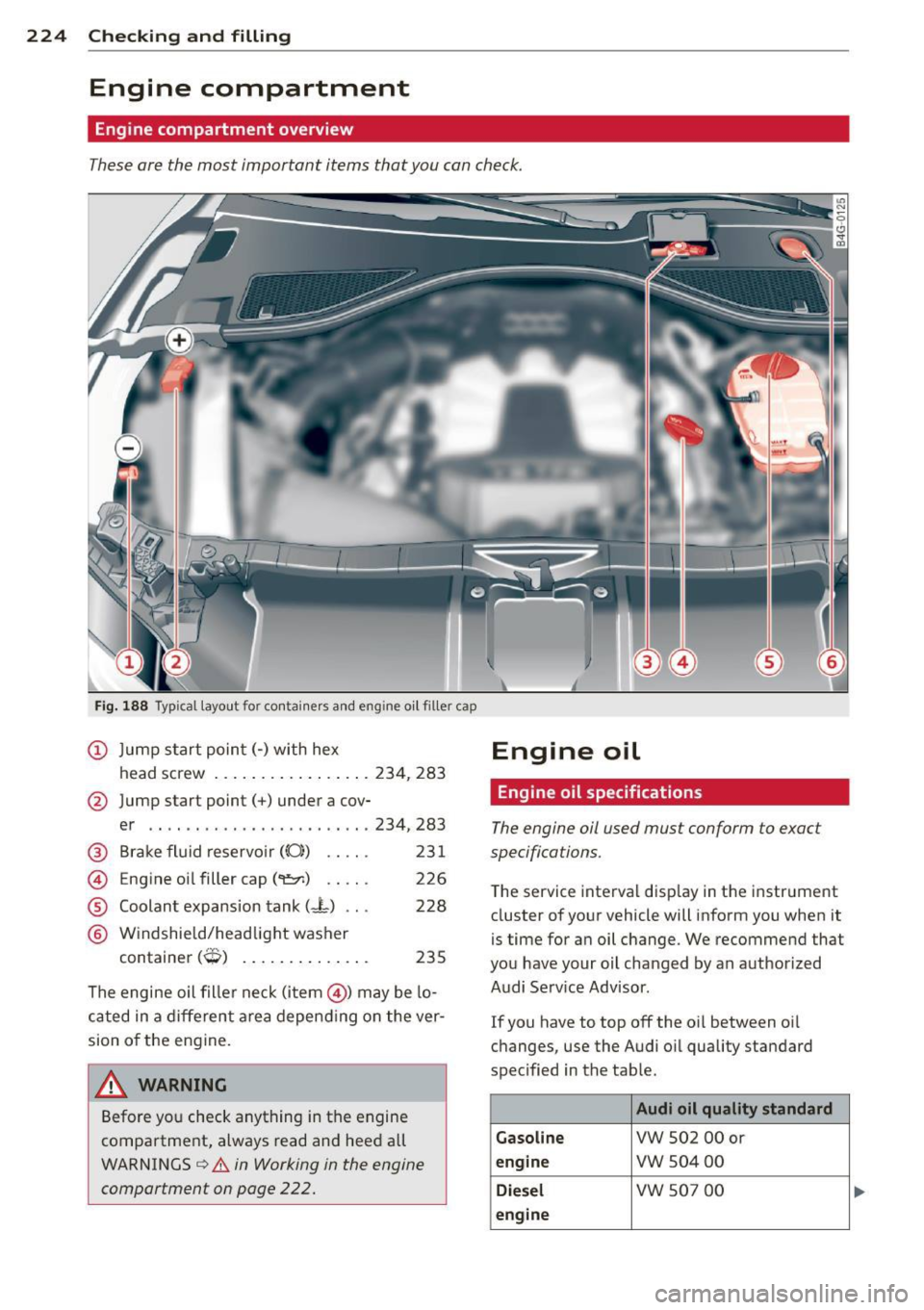
224 Checking and filling
Engine compartment
Engine compartment overview
These are the most important items that you can check.
Fig. 188 Typ ical layout for contai ners and eng ine o il filler cap
(D Jump start point(-) with hex
head screw .... ............. 234, 283
@ Jump start point(+) under a cov-
er .. .. ............... .... . 234,283
@ Brake fluid reservoir ((0)) . . . . . 231
© Engine oil filler cap (
® Coolant expansion tank (-L) ... 228
Windshield/headlight washer
. (' " ) container O ............ . . 235
The engine oil filler neck (item @) may be lo
cated in a different area depending on the ver
sion of the engine.
~ WARNING
Before you check anything in the engine
compartment, always read and heed all
WARNINGS
¢ &. in Working in the engine
compartment on page 222.
-
Engine oil
Engine oil specifications
The engine oil used must conform to exact
specifications.
The service interval display in the instrument
cluster of your vehicle will inform you when it
is time for an oil change. We recommend that
you have your oil changed by an authorized Audi Serv ice Advisor.
If you have to top
off the oil between oi l
changes, use the Audi oil quality standard
specified in the table.
Audi oil quality standard
Gasoline
VW 502 00 or
engine vw 504 00
Diesel vw 507 00
engine
Page 227 of 314
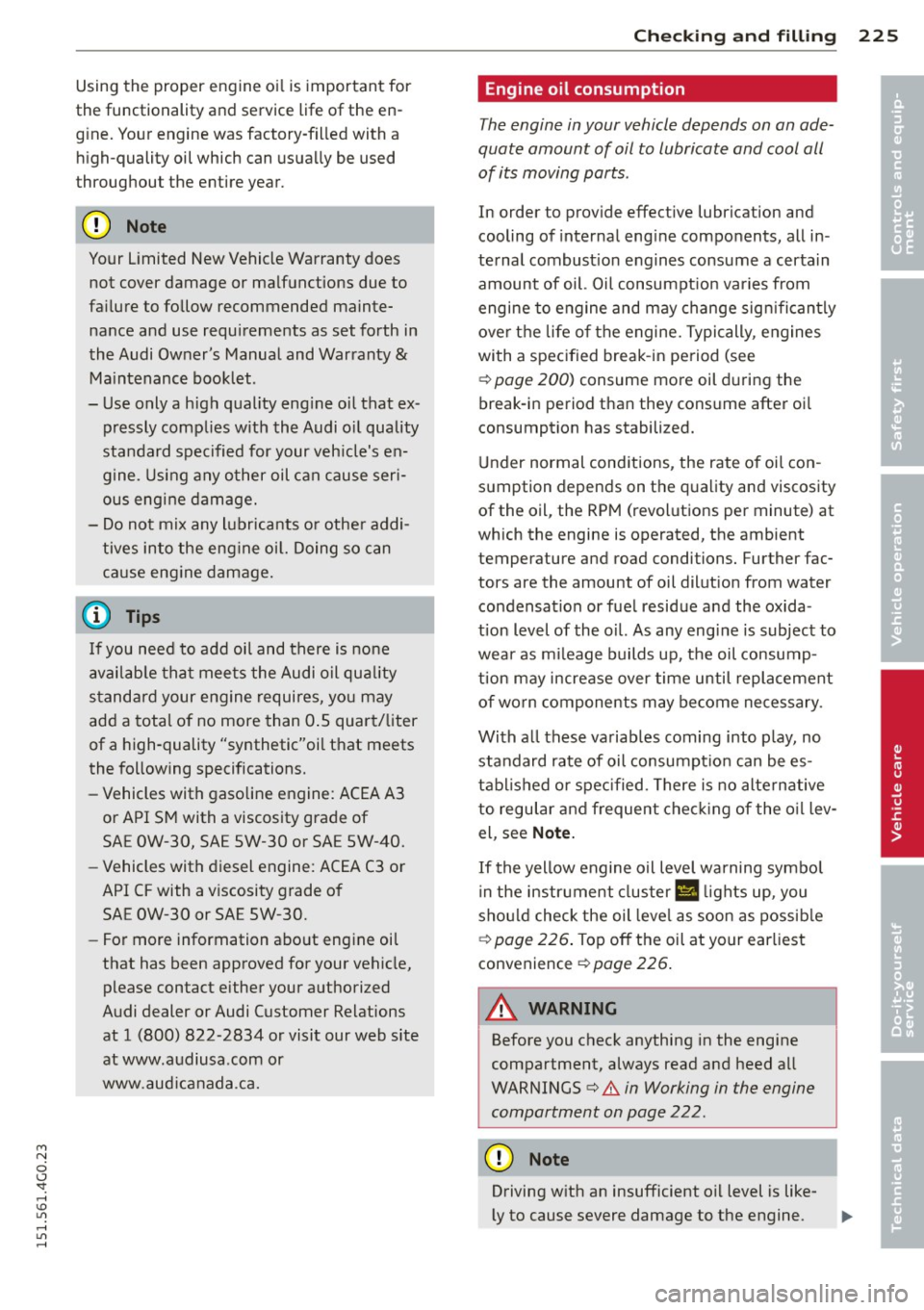
M N
0 <.J 'SI: ,...., \!) 1.1'1 ,...., 1.1'1 ,....,
Using the proper engine oil is important for
the functionality and service life of the en
gine. Your engine was factory -filled with a
high-quality oil which can usually be used
t h roughout the entire year.
Your Limited New Vehicle Warranty does not cover damage or malfunctions due to
failure to follow recommended mainte
nance and use requirements as set forth in
the Audi Owner's Manual and Warranty
&
Maintenance booklet .
- Use only a high quality engine oil that ex
pressly complies with the Audi oil quality
standard specified for your vehicle's en
gine . Using any other oil can cause seri
ous engine damage.
- Do not mix any lubricants or other addi
tives into the engine oil. Doing so can
cause engine damage.
If you need to add oil and there is none
available that meets the Audi oil quality
standard your engine requires, you may
add a total of no more than 0.5 quart/liter
of a high-quality "synthetic"oil that meets
the following specifications.
- Vehicles with gasoline engine: ACEA A3
or API SM with a viscosity grade of
SAE 0W-30, SAE SW-30 or SA E SW-40.
- Vehicles with diesel engine: ACEA C3 or
API CF with a viscosity grade of
SAE 0W-30 or SAE SW-30.
- For more information about engine oil
that has been approved for your vehicle, please contact either your authori zed
Audi dealer or Audi Customer Relations
at 1 (800) 822 -2834 or visit our web site
at www.audiusa.com or
www.audicanada .ca.
Checking and filling 225
Engine oil consumption
T he engine in your vehicle depends on an ade
quate amount of oil to lubricate and cool all
of its moving parts .
In order to provide effec tive lubrication and
cooling of internal engine components, all in
ternal combustion engines consume a certain
amount of oil. Oil consumption varies from engine to engine and may change significantly
over the life of the engine. Typically, engines
with a specified break-in period (see
c::> page 200) consume more oil during the
break-in period than they consume after oil
consumption has stabili zed.
Under normal conditions , the rate of oil con
sumption depends on the quality and viscosity
of the oil, the RPM (revolutions per minute) at
which the engine is operated, the ambient
temperature and road condi tions. Further fac
tors are the amount of oil dilution from water
condensation or fuel residue and the oxida
tion level of the oil. As any engine is subject to
wear as mileage builds up, the oil consump
tion may increase over time until replacement
of worn components may become necessary.
With all these variables coming into play, no
standard rate of oil consumption can be es
tablished or specified . There is no alternative
to regular and frequent checking of the oil lev
el , see
Note.
If the yellow engine oil level warning symbol
in the instrument cluster
II lights up, you
should check the oil level as soon as possible
c::> page 226. Top off the oil at your earliest
convenience
c::> page 226.
A WARNING
--
Before you check anything in the engine
compartment, always read and heed all
WARNINGS
c::> & in Working in the engine
compartment on page 222.
(D Note
Driving with an insufficient oil level is like-
ly to cause severe damage to the engine. .,.
•
•
Page 228 of 314

226 Checking and filling
@ Tips
-The oil pres sure warning display. is
not an indicator of the oil level. Do not
rely on it. Instead , check the oil level in
your engine at regular intervals, pref
erably each t ime you refuel, and always
before going on a long trip.
- If you have the impression your engine
consumes excessive amounts of oil, we
r ecommend that you consult your Audi
dealer to have the cause of your concern
properly diagnosed. Keep in mind that
the accurate measurement of oil con
sumption requires great care and may
take some time. Your Audi dealer has in
str uctions about how to measure oil con
sumption accurately.
Checking the engine oil level
Fig. 189 Display: o il level indicato r
"'"Park your vehicle on a level surface .
"'"Shu t the engine off when it is warm.
"'" Switch only the ignition back on.
"'"W ait approximately two min utes .
"'" Se lect:
I CAR I function button > (Car)* sys-
tems
con trol button > Servicing & checks >
Oil level.
"'"Check the oil level in the display¢ fig. 189 .
Add engine oil if the bar of the oil level indi
cator is near "min" ~
page 226 .
Depending on the way the veh icle is driven
and the operating conditions, oil consumption
can be up to 1/2 quart per 600 m iles (0.5 liter
per 1,000 km) . Consumption may be higher
within the f irst 3,000 miles (5,000 km).
(D Tips
The oil leve l indicator in t he MMI Display is
on ly an information display. If the oil level
i s low, a min imum oil warn ing appears in
the instrument cluster. Add oil
¢
page 226. If the hood has been opened,
the current oil level is shown in the instru
ment cluster the next t ime the ignition is
switched on.
Adding engine oil~
Fig . 190 Engine compa rtment: cover on the e ngin e oi l
filler neck
Before you check anything in the engine com
partm ent,
always read and heed all WARN
INGS
¢ A in Working in the engine compart
ment on page 222.
"'" Shut the eng ine off.
"'"U nscrew the cap
'1:::::11 to the engine oi l filling
hole ¢
fig. 190, ¢ page 224, fig. 188 .
"'"Carefully top off with 0 .5 quarts (0 .5 liters)
of the appropriate oil¢
page 224.
"'" Check the oil level again after two minutes
¢ page 226, Checking the engine oil level.
"'"Top off the o il aga in, if necessary .
"'" Screw the cap back on the fi lling hole .
_&. WARNING
-While topping off, the oil must not come
in contact with hot e ngine parts -fire
hazard!
- The oil filler cap must be properly se
cured to prevent oil from being sprayed
on the hot engine and exhaust system
when the engine is running -fire hazard! ..,_
Page 229 of 314
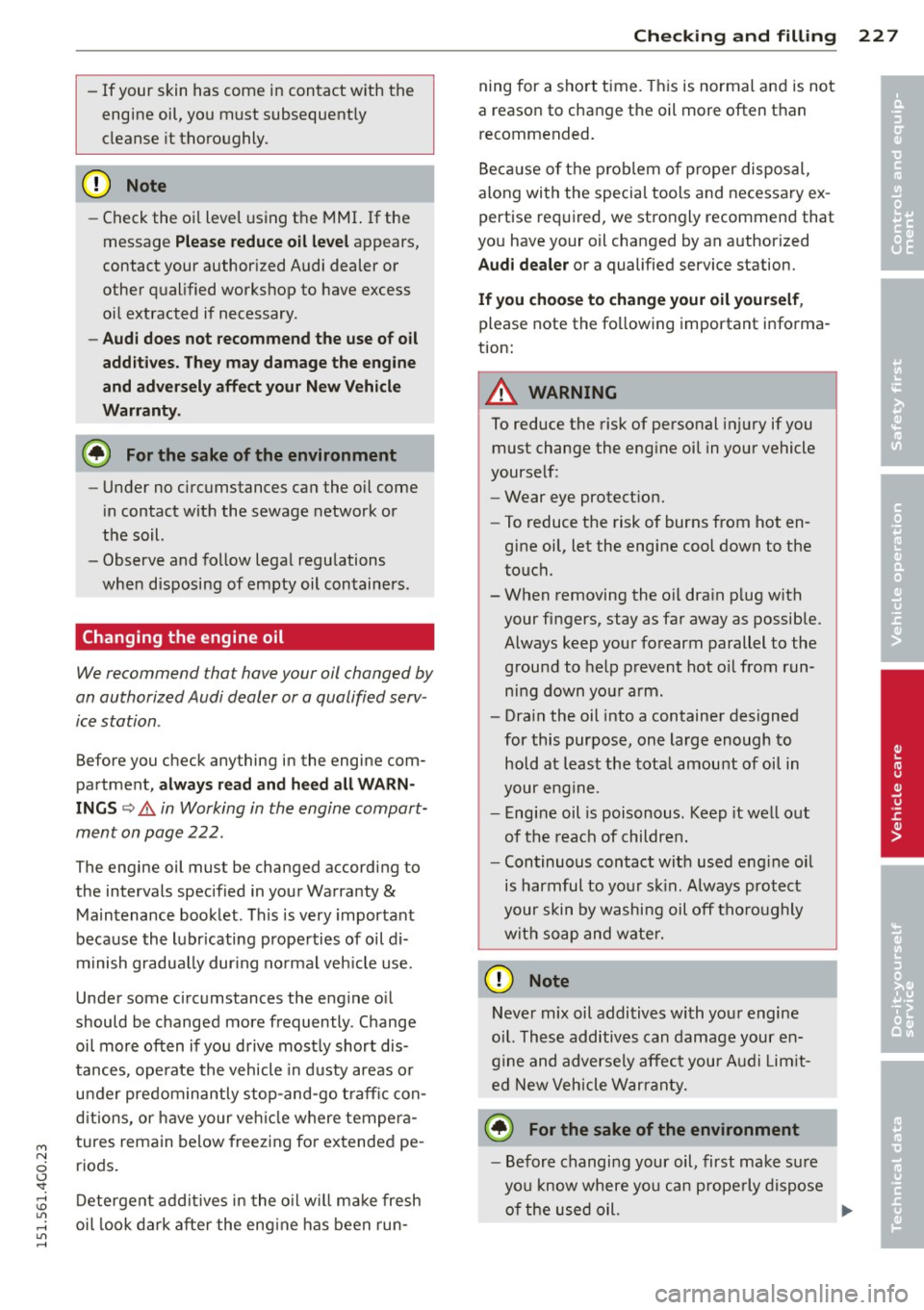
M N
0 <.J 'SI: ,...., \!) 1.1"1 ,...., 1.1"1 ,....,
-If your skin has come in contact with the
engine oil, you must subsequent ly
cleanse it thoroughly.
0 Note
- Check the oil leve l using t he M MI. If the
message
Please reduce oil level appears,
contact your author ized Audi dealer or
other qualified workshop to have excess
oi l extracted if necessary .
-Audi does not recommend the use of oil
add it ives. They may damage the engine
and adversely affect your New Vehicle
Warrant y.
@ For the sake of the environment
-Under no circumstances ca n the o il come
i n contact wit h the sewage network or
the soil.
- Observe and fo llow lega l regu lations
when disposing of em pty oil con tainers .
Changing the engine oil
We recommend tha t have your oil changed by
an authorized Audi dealer or a qualified serv
ice station .
Before you check any thing in the engine com
pa rtment,
always read and heed all WARN
INGS
~ .&. in Working in the engine compart
ment on page 222 .
The engine oil must be changed according to
the intervals specified in your Warra nty
&
Ma intenance book let . This is very important
because the l ubr icating prope rties of oil di
m inish gradua lly dur ing no rmal veh icle use.
Unde r some circumstances the engine o il
should be changed more frequently . Change
oil more often if you driv e most ly short dis
tances , ope rate the vehicle in d usty areas or
u nd er predomin antly stop-and-go t raff ic con
di tions , or have your veh icle w here tempe ra
tures remain below free zing fo r ex tended pe
riods .
D etergen t additi ves i n the o il w ill ma ke fresh
oil look dark a fter the eng ine has been run -
Checkin g and fillin g 22 7
ning for a sho rt time. This is normal an d is not
a reaso n to cha nge the oil more often t han
recommended.
Bec ause of t he pro blem o f proper disposal,
along wi th the specia l tools and necessa ry ex
pertise req uired, we st ro ngly recommend that
you have your oil changed by an a uthorized
Audi dealer or a qualified service station.
If you choose to change your oil yourself ,
please note the following important info rma
t ion:
_& WARNING
To reduce the risk of pe rsonal inj ury if you
must change the eng ine oil in your vehicle
yourself:
- Wear eye protect io n.
- To reduce t he risk of burns from hot en -
gine oil, let the engine c ool down to the
touch.
- When removing the o il dra in p lug with
your fingers, stay as fa r away as possible .
Always keep you r forearm parallel to the
grou nd to help prevent hot o il from run
ning down you r arm.
- Dra in the oil into a container designed
for this purpose, one la rg e enough to
hold at l east the tota l am ou nt of oil in
your engine.
- Engine oil is poisonous. Keep it well o ut
of the rea ch of childre n.
- Con tinuous contact wit h used eng ine o il
is harmful to yo ur ski n. A lways protect
your skin by washi ng oil off t horoughly
w it h s oap and w ater.
d) Note
N eve r mix oil additives wi th you r engine
oil. Th ese additives can damage your en
g ine and adversely affect your Au di Li m it
e d N ew Vehicle Warr anty.
(® For the sake of the environment
- Befor e changi ng your oil, first make s ure
yo u k now where yo u ca n prope rly dispose
o f the used oil.
1J11>
•
•
Page 230 of 314
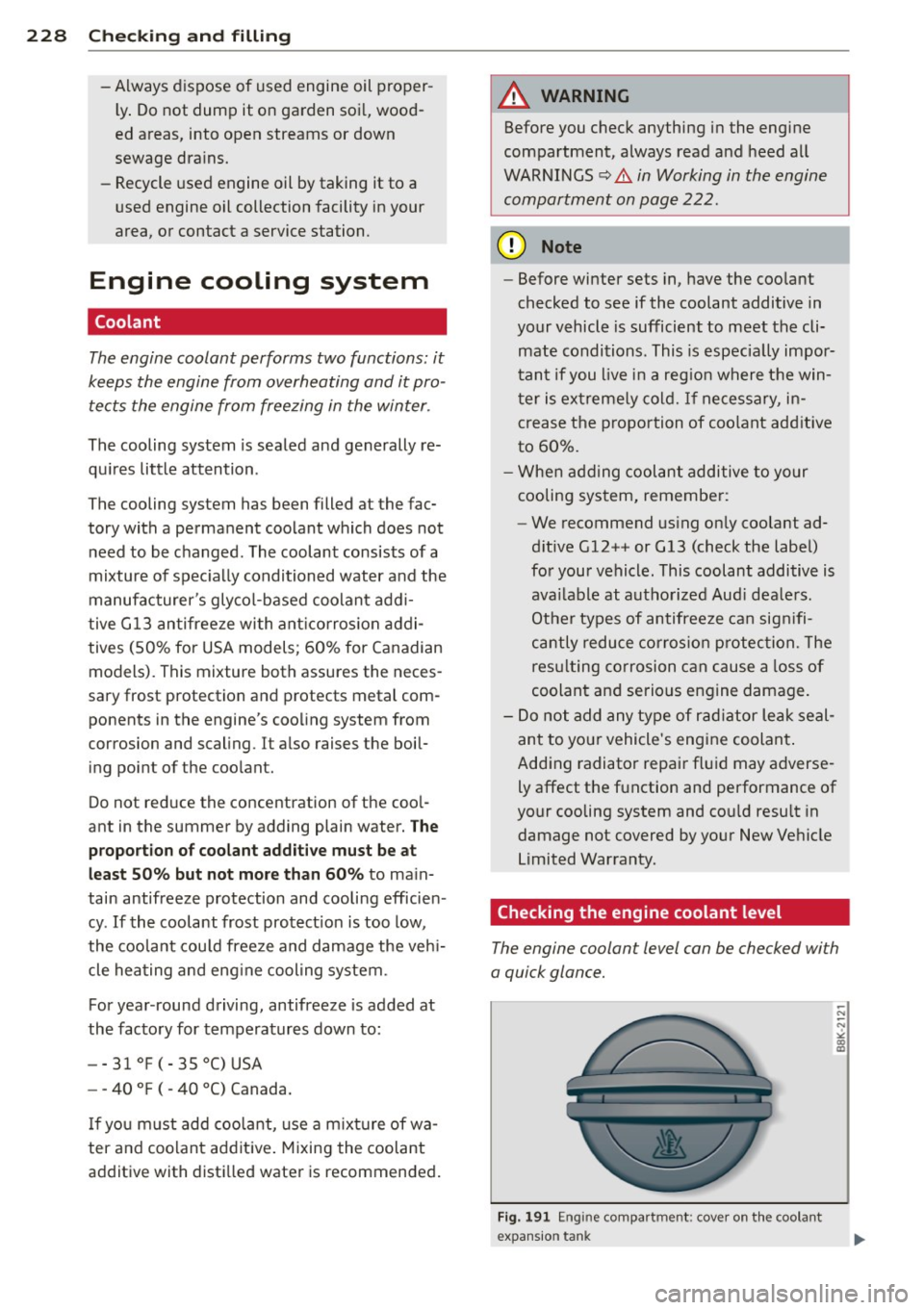
228 Check ing and filling
- Always dispose of used engine oil proper
l y . Do not dump it on garden soi l, wood
ed areas, into open streams or down
sewage dra ins.
- Recycle used engine oil by taking it to a
used engine oil collection facility in your
area, or contact a service station.
Engine cooling system
Coolant
The engine coolant performs two functions: it
keeps the engine from overheating and it pro tects the engine from freezing in the winter.
The cooling system is sealed and generally re
qu ires little attention.
The cooling system has been filled at the fac
tory with a permanent coolant which does not need to be changed. The coolant consists of a
mixture of spec ially conditioned water and the
manufacturer's glycol-based coolant addi-
tive G13 antifreeze with ant icorros ion addi
tives (50% for USA models; 60% for Canadian
models). This mixture both assures the neces
sary frost protection and protects metal com
ponents in the engine's coo ling system from
corrosion and scaling . It also raises the boil
ing point of the coolant.
Do not reduce the concentration of the coo l
ant in the summer by adding plain water.
The
p ropo rtion of coolant add itive must be at
l e a st 50 % but not mo re th an 60 %
to ma in
tain antifreeze protection and cooling efficien
cy . If the coolant frost protect ion is too low,
the coo lant cou ld freeze and damage the veh i
cle heating and eng ine cool ing system.
For year-round driving, antifreeze is added at
the facto ry for temperatures down to:
- -31°F(-35°C)USA
- -40 °F ( -40 °C) Canada.
If you m ust add coo lant, use a m ix tu re of wa
ter and coo lant addit ive . M ixing the coolant
additive with disti lled water is recommended .
A WARNING
Before you check anything in the engine
compartment, always read and heed all
WARNINGS~ &.
in Working in the engine
compartment on page
222 .
(D Note
-Before winter sets in, have the coolant
checked to see if the coolant additive in
your vehicle is sufficient to meet the cli mate conditions. This is especia lly impor
tant if you live in a reg ion where t he win
t er is ex treme ly cold. If necessary, in
crease the p roportion of coo lant add it ive
to 60% .
- When adding coolant addi tive to yo ur
c ooling sys tem, remembe r:
- We recommend us ing on ly coolant ad
d itive G12++ or G13 (check the label)
for your vehicle . This coolant additive is
ava ilable at autho rized Aud i dea le rs.
Other types of antifree ze ca n sign ifi
ca ntly reduce co rros io n protec tion. The
res ulting corrosion c an cause a loss of
coolant and serious engine damage.
- Do not add any type of r ad iator le ak seal
ant to yo ur vehicle 's engine coolant .
Adding radiator repair flu id may adverse
ly affect the function and performance of
your cooling system and cou ld resu lt in
damage not covered by your New Vehicle Limited Warranty.
Checking the engine coolant level
-
The engine coolant level can be checked with
a quick glance.
F ig. 1 91 Engi ne compartment: cover on the coola nt
expansio n tank
Page 231 of 314

M N
0 <.J 'SI: ,...., \!) 1.1"1 ,...., 1.1"1 ,....,
Before you check anything in the engine com
partment,
al ways r ead and heed all W ARN
ING S r=;, A in Working in the engine compart
ment on page 222.
.. Park your vehicle on a level surface.
.. Switch
off the ignition .
.. Read the eng ine coolant leve l from the cool
ant expansion tank¢
fig. 191, ¢ page 224,
fig. 188.
With a cold engine, the coolant
level should be between the "min" and
"max" markings. When the engine is warm,
the leve l may be slightly above the "max"
mark ing .
The location of the coolant expans ion tank
can be seen in the engine compartment illus
tration ¢
page 224.
To obta in an accurate read ing, the engine
must be switched
off.
The expansion tank in your vehicle is equipped
with an electric coolant level sensor.
When the coo lant level is too low, the warning
light in the Auto-Check System
¢ page 16 will
illum inate until yo u add coolant and the level
has been restored to normal. Even though
there is an electric coo lant level sensor, we
still recommend you check the coolant leve l
from time to time .
Coolant loss
Coolant loss may indicate a lea k in the cooling
system. In the event of coolant loss, the cool
ing system should be inspected immediately
by your authorized Audi dealer . It is not
enough merely to add coola nt.
In a
sealed system, losses can occur only if
the boiling point of the coolant is exceeded as
a result of overheat ing .
A WARNING
The coo ling system is unde r pressure and
c an get ve ry ho t. Reduce the risk of s cald
ing from h ot coolan t by followi ng these
steps .
- T urn
off the engine and allow it to coo l
down.
Checkin g and fillin g 229
-Protect your face, hands and arms from
escaping flu id and steam by covering the
cap with a large, th ick rag.
- Turn the cap slowly and very carefully in
a counter-clockwise d irect ion while ap
plying lig ht, downward pressure on the
top of the cap .
- To avo id being burned, do not sp ill anti
freeze or coolant on the exhaust system
or hot engine parts. Under certa in cond i
tions, th e ethylene glycol in engine coo l
ant can catch fire.
(D Note
Do not add any type of radiator leak sea l
ant to your ve hicle's engine coolant. Add-
i ng radiator repa ir flui d may adverse ly af
fe ct the funct ion a nd pe rfo rma nce of you r
co oling system and could re sult in damage
not covered by your New Vehicle Limi ted
War ranty.
Adding coolant
Be very careful when adding engine coolant.
Before you ch eck anyth ing in the eng ine com
partment,
alway s re ad and heed all WARN
INGS ¢ A in Working in the engine compar t
ment on page 222.
.. Requirement: The re must be a residua l
amount of coolan t in the expansion ta nk
¢(D .
.. Tu rn off the engine.
.. Let the engine cool down.
.. Place a thick rag ove r th e coo lant expansion
tank
¢ page 228, fig . 191 and carefully
twist the cap counte r-clockwise ¢.&, .
.. Add coo lant m ixed in the correct ratio
¢
page 228, Coolant up to the MAX mark
ing .
.. Make s ure that the flu id leve l remains sta-
b le. Add more coo lant if ne cessary.
.. Twis t the cap o n again
t ightly.
Replacement engine coo lant must confo rm to
exact spec ificat ions
r=;, page 228, Coolant. ..,.
•
•
Page 232 of 314
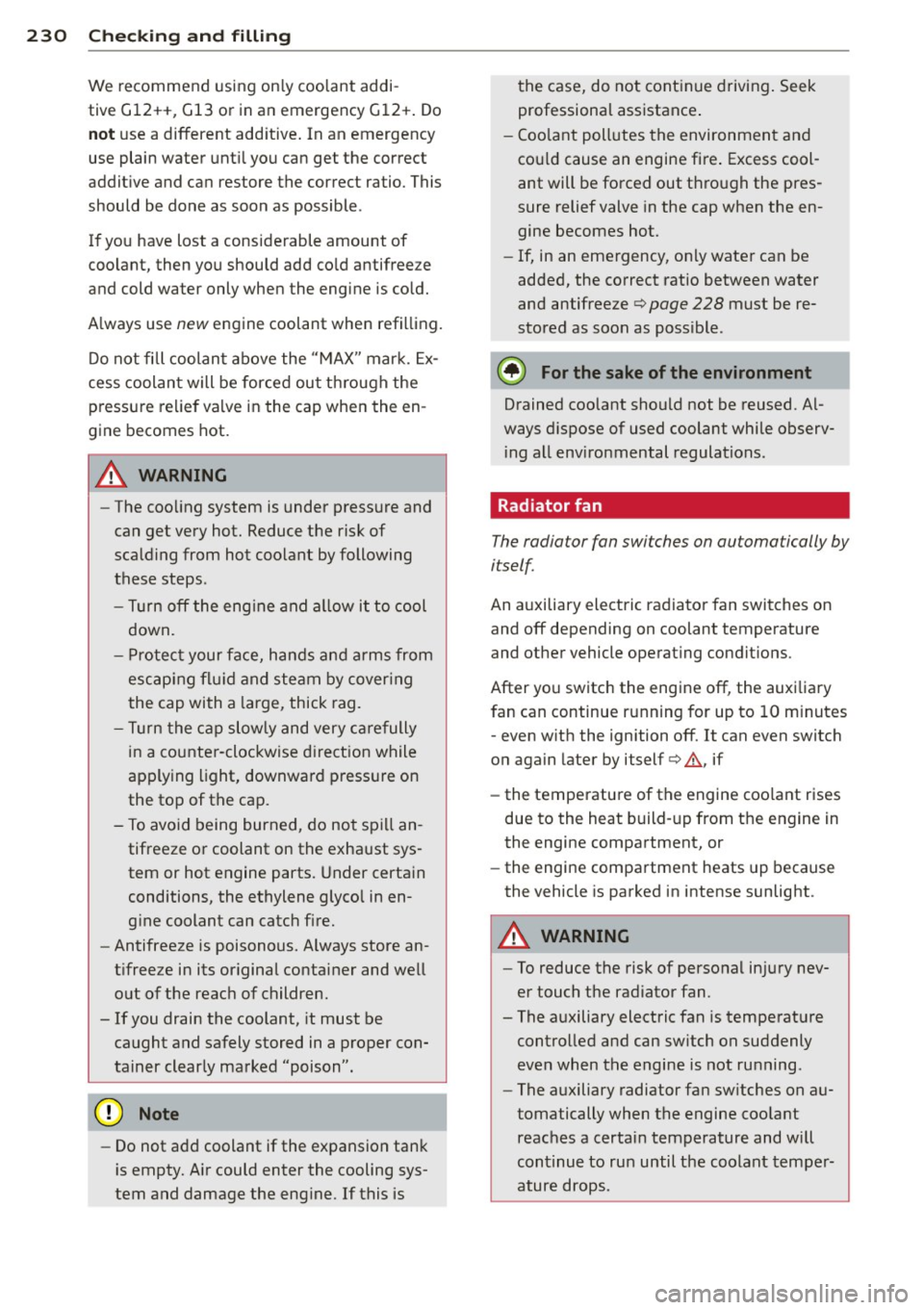
230 Check ing and filling
We recommend using on ly coo lant addi-
tive
Gl2++, Gl3 or in an emergency Gl2 +. Do
not use a different additive . In an emergency
use plain water unt il you can get the correct
additive and can restore the correct ratio. This
should be done as soon as possible .
If you have lost a cons iderable amount of
coolant, then you should add co ld antifree ze
and cold water only when the engine is co ld.
A lways use
new engine coolant when refilling.
Do not fill coolant above the "MAX" mark. Ex
cess coolan t will be forced out through the
p ressure relie f valve in the cap when the en
gine becomes hot.
A WARNING
- The coo ling system is under press ure and
can get very hot. Reduce the risk of
sca lding from hot coolant by following
these steps.
- Turn off the eng ine and a llow it to cool
down.
- Protect your face, han ds and arms from
escap ing fl uid and steam by cover ing
the cap with a large, thick rag.
- Tur n the cap slowly and very c arefully
in a counter-clockwise d irect ion while
applying light, downward press ure on
the top of the cap .
- To avo id being burned, do not sp ill an
tifreeze or coolant on the exhaust sys
tem or hot engine parts. Under certain
conditions, the ethylene glyco l in en
g ine coolant can catch fire.
- Antifreeze is poisonous. Always store an
t ifreeze in its or iginal container and well
out of the reach of children.
- If you drain the coolant, it must be
caught and safely stored in a proper con
tainer clear ly marked "poison".
- Do not add coolant if the expansion tank
is empty. A ir could enter the cooling sys
tem and damage the eng ine. If this is the case, do not cont
inue driving . Seek
professiona l assistance .
- Coo lant poll utes the environmen t and
co uld cause an engine fire . Excess cool
ant will be forced out thro ugh the pres
sure relief valve in the cap when the en
gine becomes hot.
- If, in an eme rgency, only wate r can be
added, the correct ratio between water
and antifreeze
c::> page 228 must be re
stored as soon as possible .
@ For the sake of the environment
Drained coolant should not be reused . A l
ways d ispose of used coolant while observ
i ng all environmental regulations .
Radiator fan
The radiator fan switches on automatically by
itself.
An a uxiliary electric radiator fan switches on
and off depending on coolant temperature
and other vehicle operat ing condit ions .
After yo u switch the engine off, the auxi liary
fan can continue r unning for up to 10 minutes
- even w ith the ignition off . It can even switc h
on again later by itself
c::> .& , if
- the temperature of the engine coo la nt rises
due to the heat build- up from the engine in
the engine compartment, or
- the engine compa rtment heats up because
the vehicle is parked in intense sunlight.
A WARNING
- To reduce the risk of personal injury nev
er touch the radiator fan.
- The a uxiliary electric fan is temperat ure
controlled and can sw itch on suddenly
even when the engine is not ru nning .
- The a uxiliary radiator fan sw itches on a u
tomatically when the engine coo lant
reaches a certai n temperature and will
continue to run until the coolant temper
ature drops.